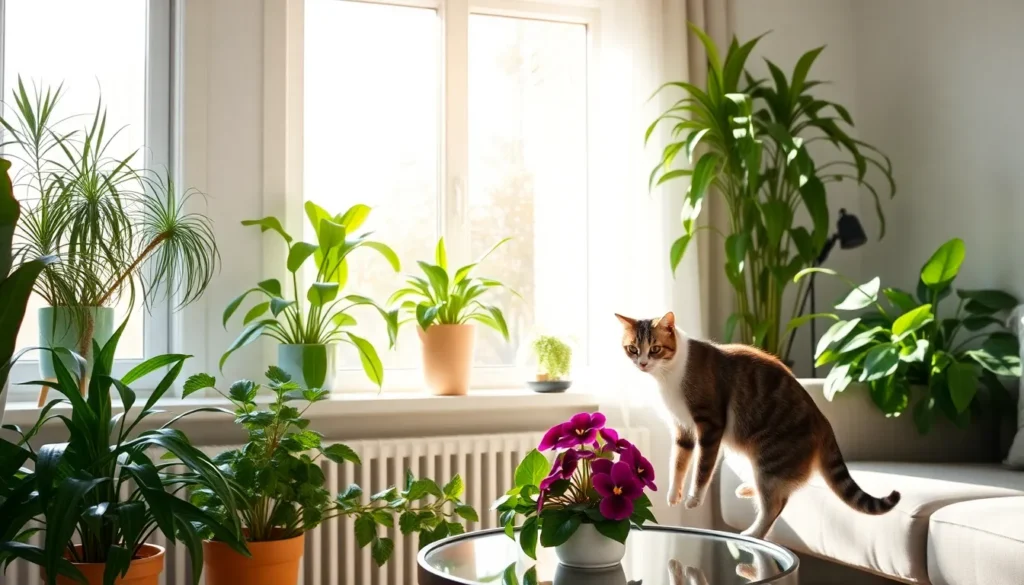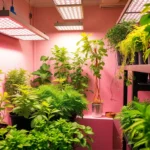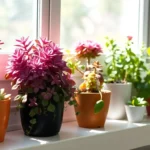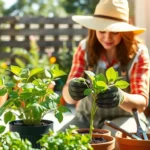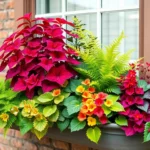We all want our homes filled with beautiful greenery but keeping cats safe while decorating with plants can feel like walking a tightrope. Many popular houseplants are toxic to our feline friends and can cause serious health issues if nibbled or ingested.
The good news? You don’t have to choose between a plant-filled paradise and your cat’s wellbeing. Dozens of stunning cat-safe houseplants can transform your space without putting your furry family member at risk.
We’ve researched the best non-toxic options that’ll satisfy your green thumb while keeping curious cats completely safe. From vibrant flowering plants to lush foliage that purifies your air these pet-friendly varieties prove you can have both beauty and peace of mind in your home.
Choose Low-Maintenance Cat Safe House Plants for Beginners
Selecting the right cat safe house plants becomes effortless when you start with varieties that practically care for themselves. We’ve identified three exceptional beginner friendly options that thrive with minimal attention while keeping your feline friends completely safe.
Spider Plant (Chlorophytum Comosum)
Spider plants top our list of cat safe house plants because they’re nearly impossible to kill and actually benefit from occasional neglect. These resilient beauties produce cascading baby plantlets that create stunning visual displays without requiring any propagation skills. We love how spider plants tolerate irregular watering schedules and adapt to various lighting conditions from bright indirect light to partial shade.
Maintenance couldn’t be simpler with these hardy performers. Water them when the top inch of soil feels dry, which typically occurs every 7 to 10 days depending on your home’s humidity levels. Spider plants naturally purify indoor air by removing formaldehyde and xylene, making them functional additions to any room. Their green and white striped leaves add instant texture to spaces while their dangling plantlets create natural hanging garden effects that cats find fascinating but harmless to explore.
Boston Fern (Nephrolepis Exaltata)
Boston ferns deliver lush, tropical vibes to cat safe house plants collections while requiring surprisingly little specialized care from beginners. These feathery beauties thrive in bathroom environments where natural humidity levels eliminate most watering guesswork. We recommend placing Boston ferns in bright, indirect light where they’ll develop their characteristic full, arching fronds that create natural privacy screens.
Watering success comes from maintaining consistently moist but not waterlogged soil conditions. Check the soil every few days by inserting your finger about an inch deep into the potting mix. Boston ferns appreciate weekly misting during dry winter months when indoor heating systems reduce ambient humidity levels. Their non toxic nature means curious cats can safely investigate these plants without any health concerns, though the delicate fronds might suffer from excessive feline attention.
Parlor Palm (Chamaedorea Elegans)
Parlor palms bring elegant tropical aesthetics to cat safe house plants arrangements while tolerating the low light conditions that challenge many other species. These compact palms rarely exceed 4 feet in height indoors, making them perfect for apartments and smaller living spaces. We appreciate how parlor palms grow slowly and maintain their shape without requiring frequent pruning or repotting sessions.
Light requirements remain flexible with these adaptable palms, though they perform best in bright, filtered sunlight away from direct rays that can scorch their delicate leaves. Water when the top 2 inches of soil become dry, which usually occurs every 10 to 14 days in average home conditions. Parlor palms naturally resist most common houseplant pests and diseases, reducing the need for chemical treatments that might pose risks to curious cats exploring nearby areas.
Select Flowering Cat Safe House Plants for Color
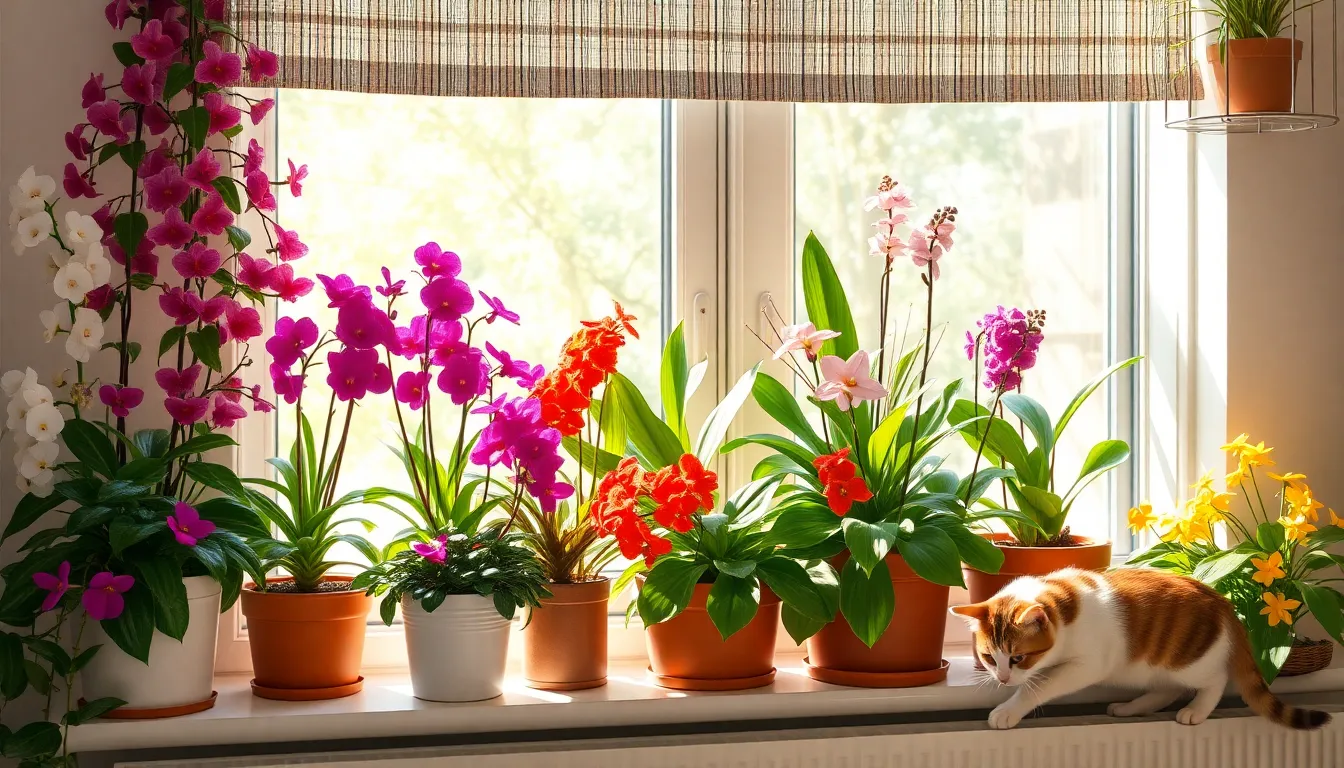
Adding vibrant blooms to your home doesn’t require sacrificing your cat’s safety. We’ve identified three stunning flowering plants that deliver beautiful colors while remaining completely non-toxic to felines.
African Violet (Saintpaulia)
African Violets transform any space with their velvety leaves and clusters of colorful flowers in violet, blue, pink, or white. These popular houseplants thrive in moderate indirect light and prefer evenly moist soil without becoming waterlogged. Their compact size makes them perfect for windowsills, shelves, or tabletops where cats might explore. We love how these plants add both color and texture to indoor spaces without creating any toxicity concerns for curious pets.
Orchids (Orchidaceae Family)
Orchids bring exotic elegance to your home with their long-lasting blooms in various vibrant colors. These diverse flowering plants generally require bright, indirect light and well-draining growing medium to flourish indoors. Their non-toxic nature makes them excellent decorative choices for households with cats who might investigate new plants. We appreciate how orchids combine stunning beauty with complete safety for our feline companions.
Impatiens (Impatiens Walleriana)
Impatiens flourish indoors when given adequate indirect light and consistent moisture. These colorful plants produce bright blooms in shades of pink, red, white, and purple that instantly brighten any room. Their non-toxic status means we can enjoy vibrant indoor color without worrying about health risks to our cats. We find these plants particularly rewarding because they bloom continuously with proper care, providing ongoing visual appeal in pet-friendly homes.
Consider Air-Purifying Cat Safe House Plants for Health Benefits
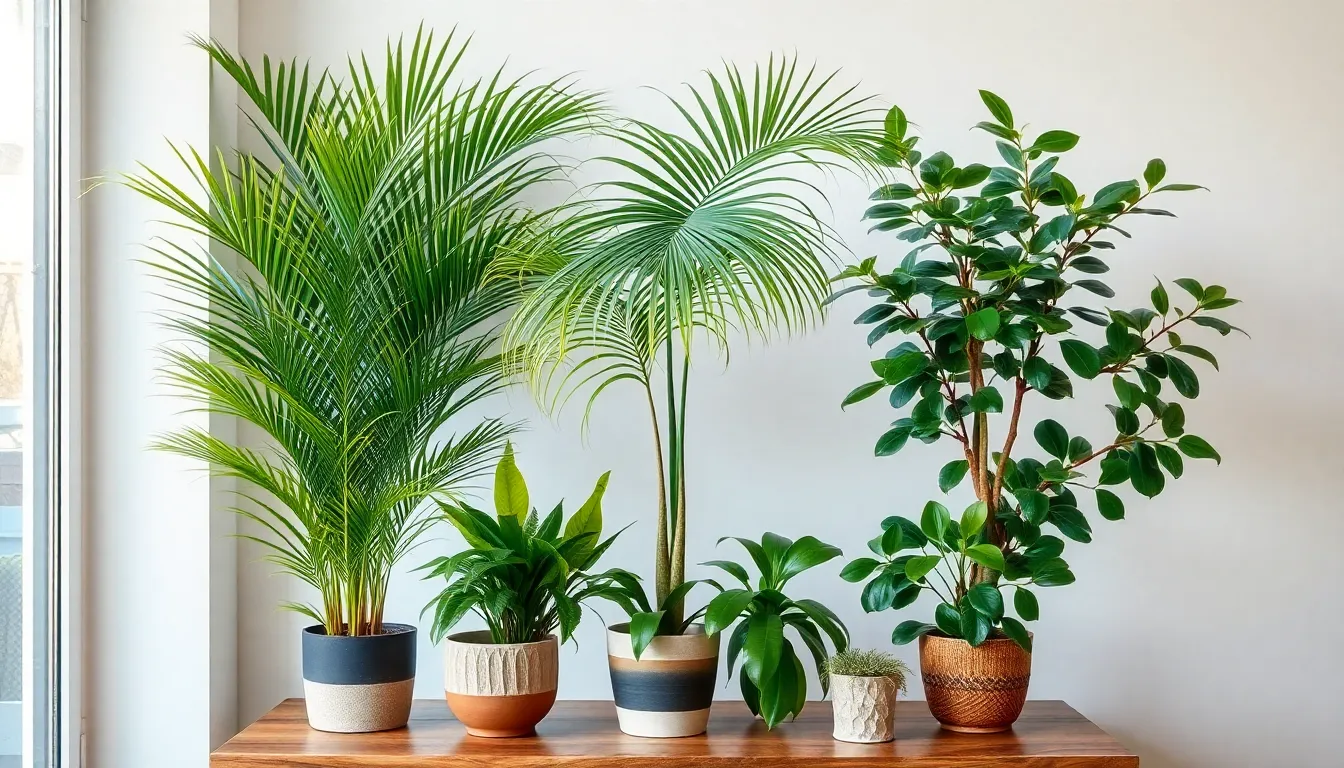
Beyond their aesthetic appeal, certain cat safe house plants actively improve our indoor air quality while keeping our feline friends healthy. We’ll explore three powerful air purifying options that transform your home into a cleaner, fresher environment.
Bamboo Palm (Chamaedorea Seifrizii)
Bamboo Palm stands out as one of the most effective cat safe air purifiers available for indoor spaces. This non-toxic palm removes formaldehyde and benzene from our air, creating a healthier environment for both cats and humans. Its feathery fronds add tropical elegance while working continuously to clean indoor pollutants.
We love that this palm is hypoallergenic, making it perfect for households with allergy sufferers. The plant’s lush appearance brings natural beauty to any room while providing peace of mind about our cats’ safety. Its air purifying capabilities significantly improve indoor air quality without requiring extensive maintenance.
Areca Palm (Dypsis Lutescens)
Areca Palm delivers exceptional air purification alongside graceful beauty that’s completely safe for cats. This palm excels at removing toxins while boosting humidity levels, creating a more comfortable indoor environment. Its arching fronds create an elegant display that enhances any room’s aesthetic appeal.
This palm’s humidity boosting capabilities help maintain healthier indoor air conditions naturally. We appreciate how it contributes to cleaner air without posing any risk to curious cats who might investigate its graceful fronds. The plant’s decorative qualities make it a popular choice for pet friendly homes seeking both function and style.
Rubber Tree (Ficus Elastica)
Rubber Tree requires careful consideration for cat households even though its excellent air purifying properties. This robust plant effectively removes airborne toxins and adapts well to indoor conditions with minimal care requirements. But, certain Ficus species can be mildly toxic to cats if ingested, making caution essential.
We recommend choosing Baby Rubber Plant varieties instead, which offer similar air purifying benefits with improved pet safety. These safer alternatives maintain the same toxin removing capabilities while providing peace of mind for cat owners. The plant’s durability makes it an attractive option for busy households seeking low maintenance air purification.
Install Hanging Cat Safe House Plants for Vertical Gardens
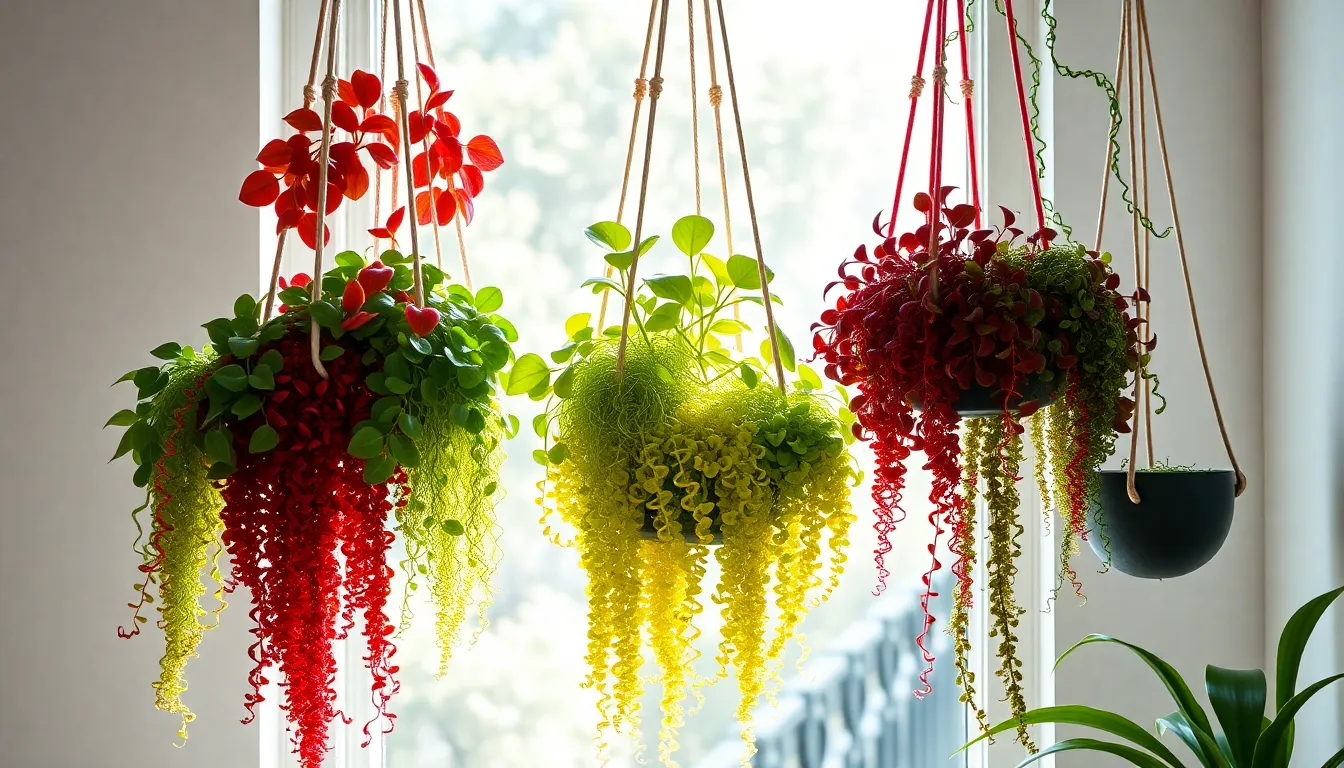
Creating vertical spaces with hanging plants allows us to maximize our green areas while keeping our feline companions safe from ground level temptations.
String of Hearts (Ceropegia Woodii)
String of Hearts creates stunning cascading displays with its delicate, heart shaped leaves trailing elegantly from hanging baskets. This plant proves completely non-toxic to cats, making it an ideal choice for pet owners who want beautiful vertical gardens without safety concerns. We recommend placing it in areas with bright indirect light where the trailing vines can showcase their romantic appearance.
Minimal watering requirements make this succulent perfect for busy households, as it thrives in well-drained soil and tolerates occasional neglect. The distinctive heart shaped foliage creates visual interest while growing up to several feet in length when properly cared for. Pet owners appreciate how this plant combines low maintenance care with absolute safety for curious cats.
Trailing Jade (Senecio Jacobsenii)
Trailing Jade offers thick, fleshy leaves that cascade beautifully in hanging containers, creating lush succulent displays throughout our homes. This plant remains completely safe for cats, allowing us to position it strategically in vertical gardens without worrying about toxic exposure. Bright light conditions help this succulent maintain its vibrant appearance and healthy growth patterns.
Infrequent watering schedules make this plant incredibly low maintenance, requiring attention only when the soil becomes completely dry. The succulent nature of Trailing Jade means it stores water efficiently, reducing our daily plant care responsibilities significantly. We find this plant particularly valuable for creating dramatic hanging displays that won’t harm our beloved pets.
Burro’s Tail (Sedum Morganianum)
Burro’s Tail produces dense, trailing stems covered in plump blue green leaves that create spectacular hanging garden features. This succulent remains non-toxic to cats, making it perfect for households where pets might investigate hanging plants from below. Bright, indirect light ensures optimal growth while preventing the delicate leaves from burning or becoming stressed.
Careful watering prevents root rot, as this plant prefers to dry out completely between watering sessions rather than maintaining constant moisture. The trailing stems can grow several feet long, creating impressive cascading effects that enhance any vertical garden space. We particularly value how this plant combines dramatic visual appeal with complete safety for our feline family members.
Position Large Cat Safe House Plants as Statement Pieces
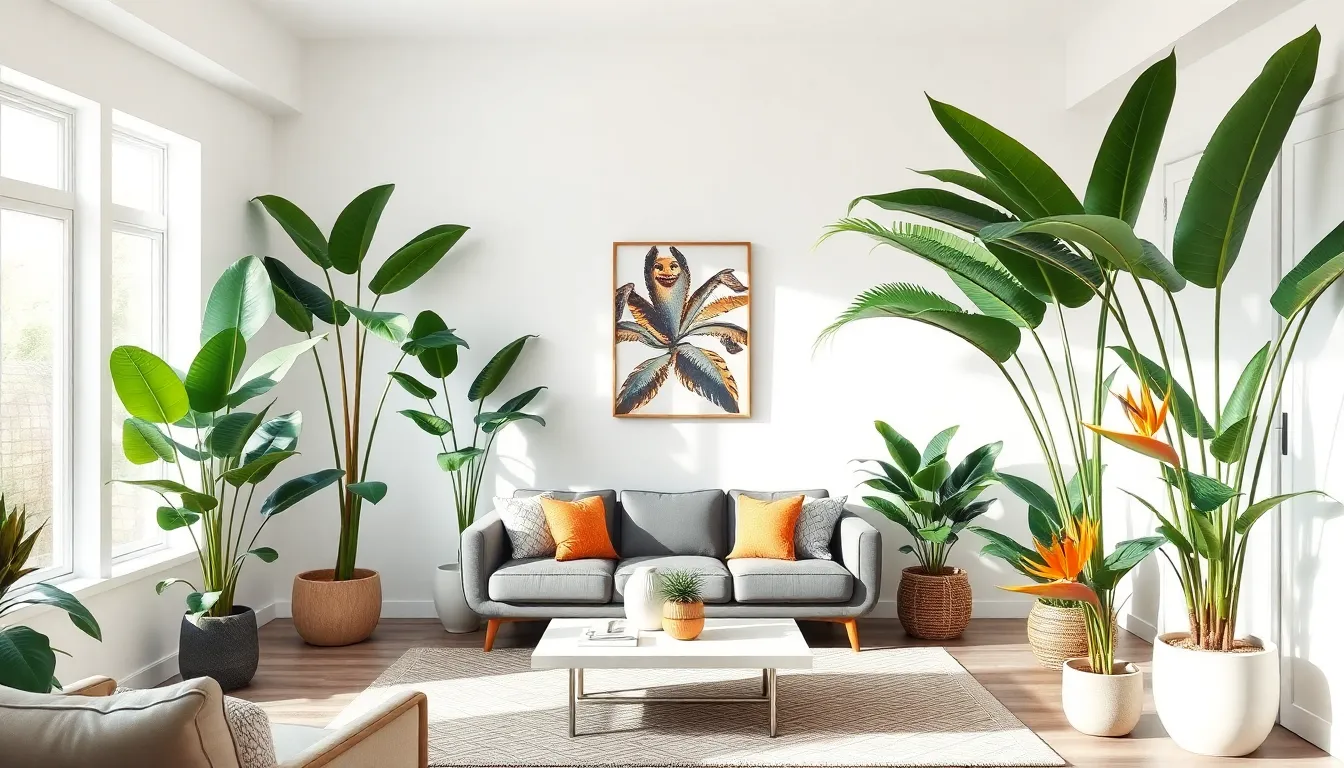
Transform your home into a stunning showcase with large cat safe house plants that serve as dramatic focal points. These impressive specimens combine safety with sophisticated style to create breathtaking visual impact.
Fiddle Leaf Fig (Ficus Lyrata)
Fiddle Leaf Figs offer bold statement making potential with their large, glossy leaves that command attention in any room. We love how this non-toxic plant creates dramatic height and texture without posing poisoning risks to curious cats. Place yours in bright, indirect light where it’ll thrive and become the centerpiece of your living space.
Moderate watering keeps your Fiddle Leaf Fig healthy while maintaining its stunning visual appeal. The plant’s sculptural form works perfectly in modern and traditional interiors alike. We recommend positioning it in corners or near windows where its impressive foliage can truly shine as a living artwork.
Majesty Palm (Ravenea Rivularis)
Majesty Palms bring tropical elegance to homes with their long, arching fronds that create instant resort vibes. This cat safe option delivers lush green presence without safety concerns for pet owners. We find it works beautifully in bright, indirect light where its fronds can spread gracefully.
Regular watering maintains the palm’s healthy fronds and keeps its tropical appearance vibrant. The plant’s natural height makes it perfect for filling empty corners or creating natural room dividers. We suggest using decorative planters to enhance its statement making power in living rooms and bedrooms.
Bird of Paradise (Strelitzia Reginae)
Bird of Paradise plants captivate with their striking banana like leaves and exotic bird shaped flowers when they bloom. We appreciate that this dramatic specimen is safe for cats while offering unmatched visual impact. Bright light conditions help it develop its characteristic large foliage that resembles tropical paradise settings.
Moderate watering supports the plant’s growth while maintaining its bold architectural form. The Bird of Paradise serves as an instant conversation starter with its unique leaf patterns and occasional vibrant blooms. We recommend placing it where guests can admire its exotic appeal without worrying about feline safety concerns.
Place Small Cat Safe House Plants on Shelves and Windowsills
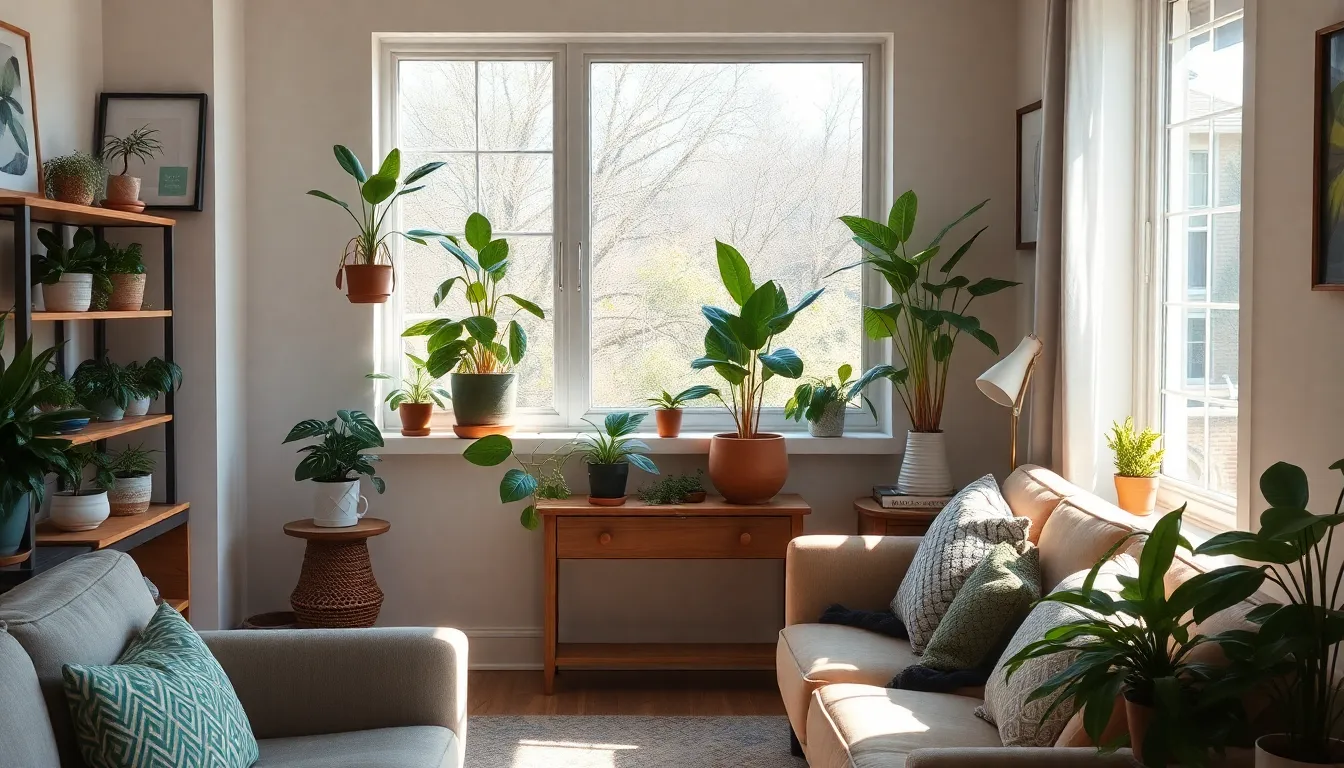
Strategic placement of small cat safe plants on elevated surfaces keeps them accessible for decoration while protecting them from heavy play areas. Elevated spots provide optimal sunlight exposure and minimize soil disturbance.
Peperomia Varieties
Peperomia plants offer thick, decorative leaves in many shapes and colors that add visual interest to any shelf display. These compact houseplants tolerate indoor lighting conditions exceptionally well and require minimal watering maintenance. We love how their diverse foliage patterns create stunning focal points without taking up excessive space. Cat owners can rest assured knowing these plants pose zero toxicity risk if curious felines decide to nibble on their leaves. Popular varieties include Peperomia obtusifolia with its rounded glossy leaves and Peperomia caperata featuring textured, heart shaped foliage.
Prayer Plant (Maranta Leuconeura)
Prayer Plants captivate viewers with their striking patterned leaves that perform the fascinating ritual of folding upward each evening. This unique “praying” behavior gives the plant its common name and creates an ever changing display throughout the day. Indirect lighting conditions suit these plants perfectly, making windowsills ideal placement locations. Moderate watering schedules keep Prayer Plants thriving without overwhelming care requirements. We appreciate how their vibrant red, green, and cream leaf patterns add tropical flair to elevated spaces while remaining completely safe for cats to investigate.
Cast Iron Plant (Aspidistra Elatior)
Cast Iron Plants earn their reputation through remarkable resilience, tolerating low light conditions and occasional neglect with grace. Their broad, dark green leaves create elegant architectural lines that complement modern and traditional decor styles equally well. We recommend these hardy specimens for pet owners seeking foolproof houseplants that require minimal intervention. Neglect tolerant characteristics make Cast Iron Plants perfect for busy households or frequent travelers. Most importantly, their non toxic properties ensure complete safety around curious cats who might explore their sturdy foliage.
Avoid Common Toxic House Plants That Harm Cats
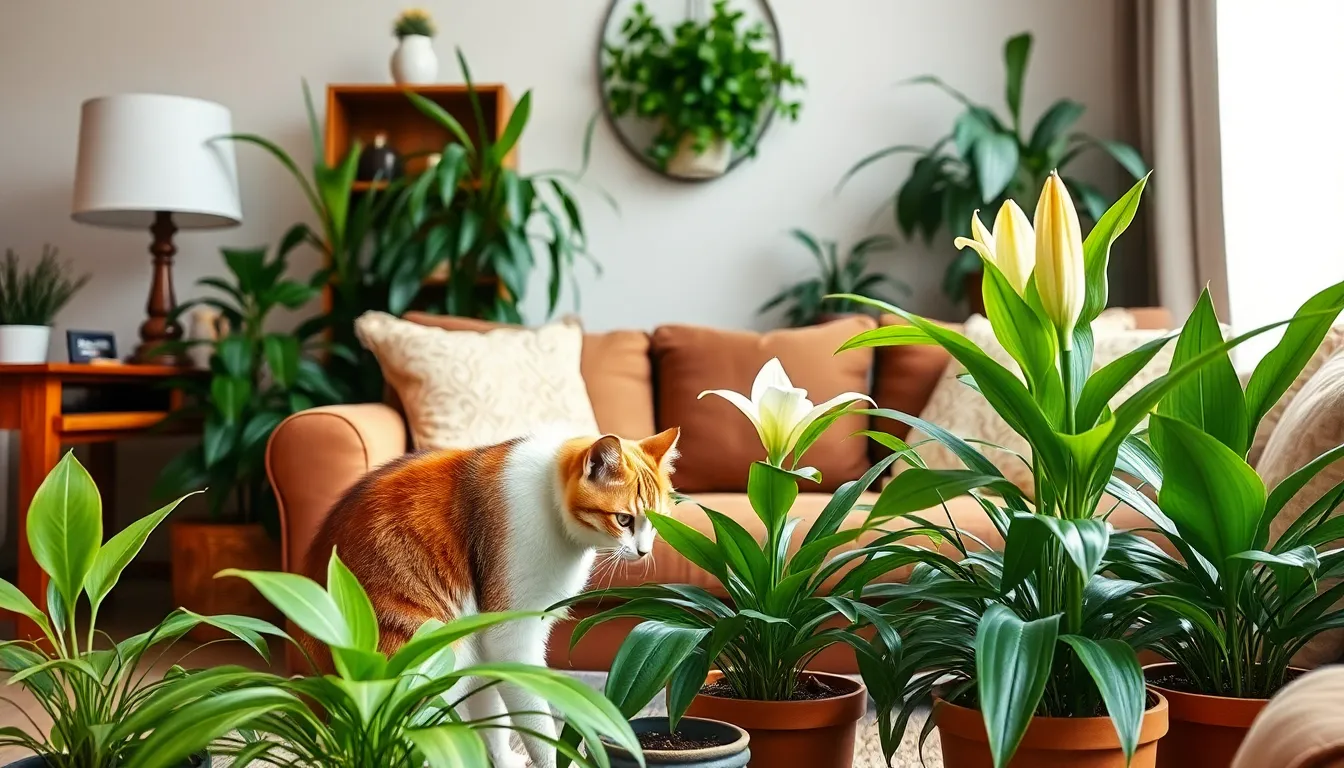
While we’ve explored beautiful cat-safe options for our homes, it’s equally important to identify plants that pose serious health risks to our feline companions. Understanding which common houseplants are toxic helps us make informed decisions and avoid potentially life-threatening situations.
Lilies and Their Deadly Effects
Lilies represent one of the most dangerous plant families for cats, causing severe kidney failure even from minimal exposure. Easter lilies, Tiger lilies, and Day lilies are particularly lethal, with just a small amount of pollen or leaf material triggering rapid kidney damage. We must completely remove these plants from our homes since even brushing against the petals can transfer toxic pollen to our cat’s fur.
Symptoms of lily poisoning develop quickly, including vomiting, lethargy, and loss of appetite within hours of exposure. Emergency veterinary treatment is essential, as kidney failure can occur within 36 to 72 hours without immediate intervention. Many pet owners don’t realize that all parts of these lilies are toxic, including the water in the vase.
Pothos and Philodendron Dangers
Pothos and Philodendrons contain insoluble calcium oxalates that cause immediate and painful reactions when cats chew on their leaves. These popular trailing plants create oral irritation, excessive drooling, and difficulty swallowing that can distress both cats and their owners. Vomiting typically follows the initial oral symptoms, making these plants particularly problematic for curious cats.
We often see these plants in homes because they’re low maintenance and attractive, but their toxicity makes them unsuitable for cat households. The calcium oxalate crystals penetrate soft tissues in the mouth and throat, causing burning sensations that can last for hours. Swelling of the mouth and throat can also occur, potentially interfering with breathing in severe cases.
Aloe Vera and Succulent Risks
Aloe Vera appears harmless and even beneficial to humans, but it’s mildly toxic to cats and can cause uncomfortable digestive symptoms. Cats who ingest aloe vera typically experience vomiting, diarrhea, and lethargy that can last several days. The saponins in aloe vera are responsible for these gastrointestinal effects, making this popular medicinal plant a poor choice for cat owners.
Succulent varieties require careful selection since some species can cause mild gastrointestinal upset in cats who nibble on them. While most succulents aren’t as dangerous as lilies or pothos, they can still cause stomach irritation and digestive discomfort. We recommend researching each succulent variety before bringing it home, as toxicity levels vary significantly between different species.
Conclusion
Creating a cat-friendly home filled with beautiful greenery doesn’t require sacrificing style or your love for plants. We’ve shown you that countless gorgeous options exist that’ll keep your feline friends safe while transforming your living space into a lush oasis.
From elegant statement plants to charming hanging varieties and vibrant flowering options you now have the knowledge to make informed choices. Remember that understanding which plants to avoid is just as crucial as knowing which ones are safe.
Your journey toward a pet-safe plant paradise starts with selecting just one or two of these recommended varieties. We’re confident that once you see how beautifully these cat-safe plants enhance your home you’ll be inspired to expand your collection even further.
Frequently Asked Questions
Can I have houseplants if I own a cat?
Yes, you can absolutely have houseplants with cats! Many beautiful, non-toxic plants are completely safe for felines. You can create a stunning, plant-filled home while keeping your cat healthy by choosing cat-safe varieties like Spider Plants, Boston Ferns, African Violets, and Orchids.
What are the best low-maintenance cat-safe houseplants for beginners?
The top three beginner-friendly, cat-safe plants are Spider Plants (resilient and air-purifying), Boston Ferns (thrive in humidity and add lush greenery), and Parlor Palms (tolerate low light and offer elegant aesthetics). These plants are easy to care for and safe for curious cats.
Which flowering plants are safe for cats?
Beautiful flowering options safe for cats include African Violets (colorful blooms with velvety leaves), Orchids (exotic elegance with long-lasting flowers), and Impatiens (vibrant, cheerful blooms). These plants add color to your home without risking your cat’s health.
Do cat-safe houseplants purify air?
Yes, many cat-safe plants also purify air! Bamboo Palms remove indoor pollutants and are hypoallergenic, Areca Palms eliminate toxins while boosting humidity, and Baby Rubber Plants offer excellent air purification. You get both health benefits and pet safety.
What are good hanging cat-safe plants for vertical gardens?
Perfect hanging plants safe for cats include String of Hearts (cascading heart-shaped leaves), Trailing Jade (thick, fleshy leaves with low maintenance), and Burro’s Tail (dense, trailing stems). These create beautiful vertical displays while keeping plants away from ground-level cat access.
Which large cat-safe plants work as statement pieces?
Impressive large cat-safe plants include Fiddle Leaf Figs (glossy leaves with dramatic height), Majesty Palms (tropical elegance with arching fronds), and Bird of Paradise (striking banana-like leaves). These create visual impact while ensuring your cat’s safety.
What small cat-safe plants are good for shelves and windowsills?
Excellent small cat-safe plants for elevated spaces include Peperomia varieties (decorative leaves, minimal maintenance), Prayer Plants (striking patterned leaves with unique “praying” behavior), and Cast Iron Plants (extremely resilient with low care requirements). These stay safely out of heavy play areas.
Which common houseplants are toxic to cats?
Dangerous plants to avoid include Lilies (can cause kidney failure from minimal exposure), Pothos and Philodendrons (cause painful oral reactions), and certain Aloe Vera varieties (mildly toxic). Always research plants before bringing them home to ensure your cat’s safety.
What are the symptoms if my cat eats a toxic plant?
Symptoms vary by plant but may include vomiting, diarrhea, drooling, difficulty swallowing, lethargy, or loss of appetite. Lily poisoning specifically can cause kidney failure. If you suspect plant poisoning, contact your veterinarian or pet poison control immediately for proper treatment.
How can I keep my cat away from my houseplants?
Use hanging planters or high shelves for smaller plants, choose cat-safe varieties to minimize risk, provide alternative cat grass for nibbling, and use deterrents like citrus peels around plants. Creating vertical gardens also keeps plants safely out of your cat’s reach.

